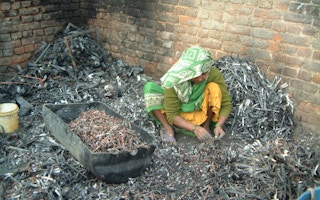In April, India’s beleaguered electronics industry unveiled a plan to reclaim market share lost to foreign brands by replacing a culture of use-and-throw with longer lasting products.
To continue reading, subscribe to Eco‑Business.
There's something for everyone. We offer a range of subscription plans.
- Access our stories and receive our Insights Weekly newsletter with the free EB Member plan.
- Unlock unlimited access to our content and archive with EB Circle.
- Publish your content with EB Premium.
Indian industry leaders reasoned that a new genre of foreign-made products like smartphones quickly become outdated and can’t easily be repaired, which is not only pinching consumers but adding to toxic e-waste dump sites across the country.
The vision to remake the Indian electronics industry is giving shape to an ambitious programme to slash e-waste in India, which is the world’s third-largest producer of discarded electronics, after China and the United States.
“Most consumer electronic products are non-repairable because the cost is too high. We need to think about how to redesign products and incorporate features that make them easy to repair and upgrade,” says Satya Gupta, chief executive of Epic Foundation, a non-profit that is spearheading the industry programme.
“If you are able to extend the life of a product from three years to five years, then you have increased the product’s lifespan by 66 per cent, Gupta says. “We have to think about the environmental impact of the product at the design stage.”
“
With the push to digitalise [the economy], electric vehicles as well as discarded solar panels, e-waste is a burgeoning crisis.
Miren Lodha, director, CRISIL Ltd
The first such product, an affordable tablet computer for students, will likely be introduced by a consortium of companies in the next three to six months, while another ten products including smart cameras are in the works, says Gupta.
The programme emerges amid a push by Indian Prime Minister Narendra Modi to promote the country as a global manufacturing hub. The Indian government has offered financial incentives worth US$13 billion to boost manufacturing in 13 sectors including electronic goods, mobile phones and electric vehicles.
India’s electronic products market is currently worth around $180 billion annually, with homegrown brands accounting for only about a 5.5 per cent share. Chinese brands such as Oppo, Vivo and Haier as well as Korea’s Samsung and LG are the dominant players.
Over the last two decades, domestic brands such as television makers BPL and Onida have lost out to foreign brands which offered better technology, but the market shift has also ushered in a culture where consumer electronics are discarded every two to three years instead of keeping them for five to seven years, say industry executives.
Traditionally, Indian households have a strong recycling culture; everything from bottles to newspapers are sold to neighbourhood trash buyers called Kabadiwalas, who process and sell used items on as feedstock. But the informal system of recycling does not work well for electronic waste, which is difficult to dismantle and often contains toxic chemicals.
Dangerous toxic piles
India generated as much as 1.01 million tonnes of e-waste in the financial year ending March 2020, according to a Central Pollution Control Board report.
“Only about 20 per cent of electronic waste in the country is recycled due to the absence of a cohesive policy programme,” says Miren Lodha, director at ratings agency CRISIL Ltd. He added that large amounts are dumped into landfill sites without being properly treated, resulting in soil and groundwater contamination.
“With the push to digitalise [the economy], [the rollout of] electric vehicles as well as discarded solar panels, e-waste is a burgeoning crisis,” says Lodha.
Only about a month ago, toxic landfills comprising mixed wastes caught on fire on the outskirts of the capital, Delhi, leaving hundreds of people shrouded in a poisonous haze for days.
Around 95 per cent of India’s e-waste recycling firms are cottage enterprises which are loosely regulated.
The Epic Foundation plans to not only help domestic enterprises design and build longer-lasting products, but also establish a domestic industry for refurbished electronic products.
Gupta thinks that India could create a billion-dollar industry from refurbished electronic products.
The Indian government also appears to be taking steps towards implementing a comprehensive e-wastes recycling programme.
On May 24, the environment ministry issued draft rules that will require consumer goods firms and electronic goods makers to ensure that at least 60 per cent of their electronic waste is collected and recycled by 2023, with targets to increase that ratio to 70 per cent and 80 per cent by 2024 and 2025, respectively.
The government also proposes to introduce a system similar to trading in carbon credits, which will allow companies to meet shortfalls through purchasing points from other sellers.
Industry executives suggested that manufacturers should incentivise consumers to exchange their old products for new ones by offering discounts or other incentives to ensure their safe disposal or reuse.
Vinod Sharma, head of the Confederation of Indian Industry’s National Electronics Committee, said that the government should cut red tape and ease restrictions on the import of electronic waste to enable India to become a global hub for making refurbished electronic products.
Currently, import duties on old or new electronic products and parts are treated on par, which makes it too expensive for makers of refurbished products, says Sharma.
“India is in a unique position. It has both a large market for electronic waste, and a culture of reuse. There is a golden opportunitiy for India become a global hub for the circular economy in electronics,” says Sharma.










